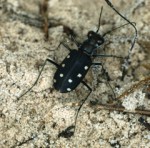
Click On Picture for Larger Image
Tiger Beetles
Author: Ray Bowers
 Click On Picture for Larger Image |
Genus: Cicindela |
Description:
Tiger beetles are from 10 to 20mm (0.5 to 0.75in) long. The head
contains strong mouthparts, long threadlike antennae, and large eyes. The thick front wings are dark with
light spots, but are held forward and not used in flight. The thin clear membranous back wings are the
flight wings. The legs are long and slender.
Geographic range:
Tiger beetles are found worldwide, with about 75% of the 119
species found in the United States found in the West. A number of different species are found in a variety
of habitats in New Mexico.
Habitat:
Tiger beetles are found in open sunny areas with sand or clay soil. They
will often stay near a path or trail.
Food Web:
The adult and larval forms are predaceous feeding on any arthropod they
can catch. Any predator that can catch them will eat them.
Reproduction and Development:
Tiger beetles undergo complete metamorphosis. The eggs
are laid in a favorable location; when the eggs hatch the somewhat S shaped larva make a burrow and wait in
the burrow to capture passing insects. As the larva grows it reaches a point in its life cycle when it goes
into a resting stage or pupa where it changes into the adult form.
Behavior:
Adult beetles are active diurnal predators, running after and pouncing on
other insects. The larva constructs a vertical burrow in the ground where they wait at the top of the
burrow for passing insects. There are curved hooks on the abdomen that are pushed into the side of the
burrow, this keeps the larva in the burrow if it grabs and insect that it too large to immediately
overcome. When the larva overcomes its prey, the prey is dragged to the bottom of the burrow and eaten. The
adults are very wary and when approached will run or fly to a safe distance, stop and face any pursuer. If
captured the jaws can give a strong bite.
Ecosystem roles:
Tiger beetles as adults and larva are important predators of other
insects.
Taxonomy:
Kingdom: Animalia
Phylum: Arthropoda
Subphylum: Atelocerata
Class: Hexapoda
Order: Coleoptera
Family: Cicundelidae
Genus: Cicindela
References:
Borror, Donald J. and Richard E. White. 1970. A Field Guide to the
Insects of America North of Mexico. Boston: Houghton Mifflin Co.
Borror, Donald J., Charles A. Triplehorn, and Norman F. Johnson. 1989. An Introduction to the Study of
Insects. Philadelphia: W. B. Saunders Co.
Bland, Roger G and H. E. Jaques.1978. How to Know Insects. Dubuque, Iowa: Wm. C. Brown Co.
Larson, Peggy and Lane Larson. 1977. The Deserts of the Southwest. San Francisco: Sierra Club Books.
MacMahon. James A.1985. Deserts. New York: Alfred A Knopf, Inc.
Werner, Floyd and Carl Olson. 1994. Insects of the Southwest. Fisher Books, LLC.
White, Richard E.. 1983. A Field Guide to the Beetles of North America. Boston: Houghton Mifflin Co.
Related Terms: Hexapoda, Insects